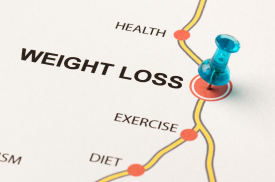Weight Loss 101: How Do I Lose Weight?

When it comes time to dropping those extra pounds, you’re most likely to have a ton of questions. There are so many different concepts out there, so many diets, so many opinions that you can feel confused and intimidated.
For everyone who’s ever asked, “Where do I start?”, I’ve put together this Weight Loss 101 guide taking you through the six basic steps you need to take to lose weight in a safe and healthy way.
While the guide is great for beginners, if you’re a yo-yo dieter or if you’ve been on a lot of “diets”, this guide is a great starting point for you as well. You’ll never go on another “diet” again.
So, here’s my six-step answer to the age-old question: “How do I lose weight?” The first step may surprise you!
Step 1 – Make Sure You’re Ready for a Change
To set yourself up for weight loss success, you need to make sure you’re ready to make a change. Don’t skip this first step. Losing weight requires major changes to your lifestyle and eating habits. If you’re not ready to make those changes, you’ll quickly get discouraged and unmotivated.
Here’s a list of the six different levels of weight loss readiness? Where are you at?
If you’re at level 3 and up, then you’re ready to make a change. It’s also a good idea to talk to your doctor before making any changes to your lifestyle, especially if you have any chronic conditions.
You also need to make sure you have the right attitude. Check out these three common mistakes people make when they want to lose weight:
This guide assumes you need to lose weight. But stop for a second and ask yourself: Do I really need to lose weight? If the answer is yes, continue on to Step 2.
Step 2 – Understand the Basic Weight Loss Formula & Set a Daily Calorie Goal
To put it in the simplest of weight loss terms: if you eat more calories than your body can burn, you’ll gain weight. Knowing how many calories your body needs and knowing how many calories you eat in day will help you understand how your body loses weight. And when I say weight, I mean body fat. The last thing you want to do is lose muscle.
- Calories in Vs. Calories Out: The Basic Formula Explained
- How Many Calories Do You Need to Lose Weight?
- Calorie Deficit Calculator
- What Percentage of Carbs Protein and Fat should you eat
When you have an idea of how many calories to eat in a day to lose weight, it’s really good idea to track your calories. FitWatch has a free 28 Day Calorie Counting Boot Camp that teaches you how to count calories using FitWatch’s free online calorie tracker.
If you’d prefer, there’s a quick rundown here:
And remember, you might lose weight on a Twinkie die but you’ll ruin your health. The quality of the calories you eat is important. You need to choose nutrient-dense foods — foods that are high in vitamins and minerals, and that provide carb, protein and important fats.
FitWatch has tons of articles on healthy eating. Just do a quick search on the site. If you’re taking the Calorie Counting Boot Camp, Week 4 covers healthy eating.
Knowing how to read food labels and understanding servings sizes is a skill you’ll need to learn to help you lose weight.
- How to Make Sense of Food Labels
- Six Serving Sizes You Need to Get Right
- 7 Things You Need to Know About Serving Sizes
Step 3 – Set a Weight Loss Goal
Setting a weight loss goal will help keep you focused — it’s quite the motivator, too! But it’s important to set realistic goals.
- How to Set a Weight Loss Goal
- How to Set SMART Weight Loss Goals
- 7 Important Steps to Setting Your Weight Loss Goals
FitWatch has a calculator that will give you an idea of how long it’ll take to lose the weight.
Step 4 – Track Your Progress
It’s important to track your progress because otherwise you won’t know what works — and waht doesn’t work — for you. Ideally, you’ll want to track your progress on a weekly basis — and then look for patterns of weight loss or weight gain over the span of a few weeks.
The FitWatch Calorie Counter can also track your weight loss progress.
Step 5 – Add in Exercise to Accelerate the Process
Changing your eating habits can go a long way to helping you lose weight. But exercise? Ah, exercise will help accelerate the fat loss — and make your body even healthier: cardio for a strong and healthy heart; weight training for strong muscles and increased bone density, and stretching to wrap it all up in a pretty bow.
Here are the basics:
- How Often Should You Exercise?
- What’s the Best Exercise for Losing Weight
- Benefits of Exercising Daily — And How to Get Started
- How to Avoid Injury While Exercising
And here are a few ways to get started:
- Want to Lose Weight and Feel Great? Enjoy a Morning Walk!
- Looking for the Best Fat Burning Work Out Routine?
- 10 Ways You Can Exercise at Home Without Any Equipment
- 10 Ways to Exercise While Watching TV
Check out the calories you can burn doing a variety of physical activities, plus a few FitWatch exercise tools calculators:
Step 6 — Keep Yourself Motivated & Watch Out for Obstacles, Challenges and Plateaus
You need to realize that there will be setbacks, challenges, tempations along the way. You’ll make some progress and then life will get in the way. The trick is to come up with a solution for obstacles, plan ahead for setbacks and refocus your efforts when you hit a plateau.
Motivation
- Weight Loss Excuse Busted! I Find it So Hard to Be Motivated In the Beginning
- 7 Ways to Boost Your Weight Loss Motivation
- 7 Ways to Keep your Motivation to Exercise
Obstacles & Temptations
- 5 Ways to Avoid Workplace Diet Temptations
- 3 Mind Tricks to Overcome Food Temptations
- Will Power & Weight Loss: Turning No Into Yes
Plateaus
Once you reach your goal weight, you’ll need to stick to your new habits. You can’t go back to your old way of eating — and you have to keep up with your exercise routine. Staying at your ideal body weight is an on-going process and is a lifelong commitment. Make changes you can live with for the rest of your life!
